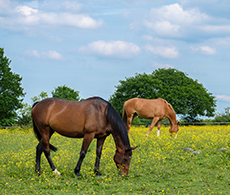
How to spot summer pasture allergy
Could your horse be suffering from a type of asthma during the warmer months? We asked Petplan Equine veterinary expert Gil Riley for his advice on spotting the signs and symptoms, and how to effectively manage the condition.
What you should know about summer pasture allergy
‘Horses, just like humans, can suffer from a type of asthma that results in narrowing of the airways, breathlessness, wheezing and coughing,’ says Gil. In fact, a recent Swiss study showed that 54% of horses suffer from a respiratory allergy of some kind, and this number is increasing – with experts pointing to rising temperatures, and prolonged pollen seasons, as a couple of causes.
While horses commonly suffer from a respiratory disease called recurrent airway obstruction (RAO), more is now being discovered about another condition that can affect your horse’s airways: summer pasture associated obstructive pulmonary disease (SPAOPD) or summer pasture allergy.
‘Just as its name suggests, SPAOPD affects horses in the warmer months when the pollen count is high,’ explains Gil.
Key triggers
‘A chief driver of SPAOPD is often oilseed rape, which flowers from late spring into summer,’ Gil says. ‘We believe the allergy is actually caused by fungi on the spores of the plants’ pollen, rather than the pollen itself.
‘Traditionally, we’ve always thought of breathing disorders as being caused by dust allergies that are worse when in the stable, as horses with dust allergies are usually better off out in the field away from dusty bedding and hay,’ he explains. ‘But SPAOPD flips that idea on its head: horses with summer pasture allergy are worse off outside because they are more exposed to pollen.’
Signs and symptoms
In horses with SPAOPD the allergen causes a reaction, which results in the clamping down of the muscles around the small airways in a horse’s lungs. ‘This means that a horse will have to breathe more heavily and rapidly to get sufficient oxygen,’ Gil says. ‘If your horse is suffering from summer pasture allergy you’ll notice signs like panting with flared nostrils, not tolerating exercise very well, and tiring quickly because he’s not getting sufficient oxygen to his muscles.’
The disease can affect older horses more severely than younger, healthier animals because they might also have other underlying conditions. For example, Cushing’s disease is commonly seen in horses over the age of 14 and can compromise the immune system, predisposing these horses to allergies.
‘In older horses we tend to see a severe onset of SPAOPD to the point where a horse can look like it’s colicking,’ adds Gil. ‘They’re often found in a lot of distress, sweating and with reddened nostrils, gums and inner eyelids. The symptoms are usually worse in the evening on a warm day, when the pollen levels have been high. It’s basically a large asthma attack.’
Horses who have been exposed to several summers can also start to develop SPAOPD. ‘Owners are shocked to find that their horse has developed the condition, as nothing in their horse’s routine has changed,’ says Gil. ‘It’s simply that the horse has developed an allergy to something in its environment that it has been repeatedly exposed to. Thankfully, the symptoms are only seen at certain times of the year – when the allergen-producing plants are gone, symptoms disappear too.’
Treatment and management
Although SPAOPD is a lifelong condition, there are effective ways of managing and treating it, so it’s important to identify the disease as early as possible and get your horse prompt medical care.
‘Treatment can also greatly improve a horse’s quality of life,’ Gil says. ‘The most effective method is to get a horse to inhale small quantities of steroid into his lungs. This will neutralise the allergic reaction that has caused the airway muscles to clamp down.
‘One way your vet might do so, is by adapting a paediatric inhaler (usually used to treat children) and turning it into a mask for your horse. A steroid is then sprayed in aerosol form into the mask, and your horse will breathe it in like an inhaler.
‘Another, more recent treatment, is an equine nebuliser where a small quantity of fluid carrying a steroid can be converted into a very fine mist (nebulised) and then inhaled. Your horse will have to wear this mask for 10 minutes in the morning and 10 minutes at night, and so far it’s proven to be a very effective treatment.’
Other treatments include using bronchodilators, which help to dilate or open up your horse’s airways, and can simply be added to his feed.
‘Along with medication, there are also ways that you can adapt your horse’s environment to ensure he’s kept comfortable,’ adds Gil. ‘If it’s warm, and there’s a high pollen count, bring your horse into a cool stable and try not to exercise him during the hottest part of the day.
And ask your vet to check your horse for any underlying health issues. If he isn’t absorbing enough nutrients, has a hormonal disease such as Cushing’s or is carrying certain parasites, such as worms, he can be more at risk of an allergic reaction.’



